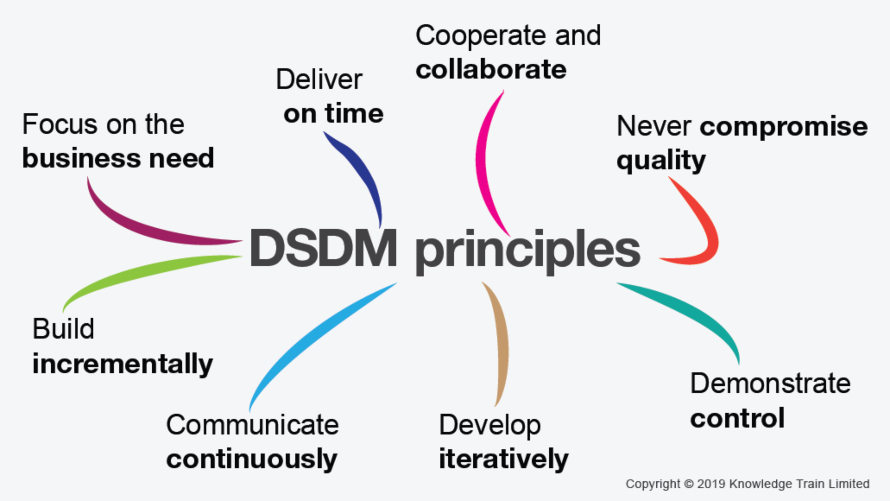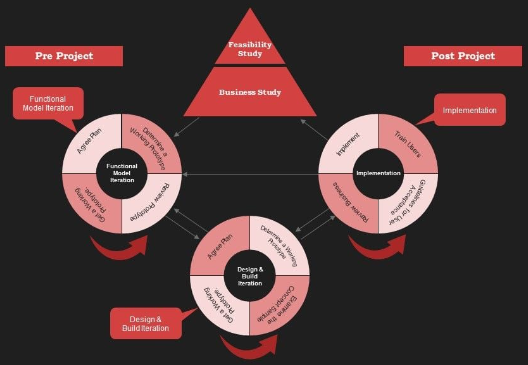Dynamic Systems Development Method (DSDM) for Agile Software Projects
Dynamic Systems Development Method (DSDM) is an agile framework that emphasizes user involvement and early, frequent deliveries to ensure software is developed effectively and efficiently. This post will delve into the principles and phases of DSDM, with a particular focus on its emphasis on collaboration, user involvement, and iterative development. Drawing comparisons to methodologies like Scrum, we’ll explore how DSDM builds on the concepts of Rapid Application Development (RAD) and integrates them to suit projects where time and budget are limited.
Overview of DSDM
Dynamic Systems Development Method (DSDM) was developed in the UK in 1994 by a consortium of suppliers and experts in the field of information systems development. It evolved as an extension of Rapid Application Development (RAD) and is particularly beneficial for projects that need to be completed within specific time and budget constraints.
DSDM is a flexible methodology that aligns well with agile development principles and prioritizes working software over extensive documentation. Below is an overview of the nine core principles that guide DSDM, emphasizing the value of individual contributions and collaborative progress.
| Principle | Description |
|---|---|
| User Involvement | Users are key to reducing errors and ensuring software meets needs. Selected users must be part of the process from start to end, frequently reviewing the product. |
| Team Decision-Making | Teams must have decision-making power to maintain agility. Dependency on external approvals slows progress. |
| Early Deliveries | Early delivery helps in quick detection of errors, reducing costs of fixing issues later. |
| Adapt to Company Needs | Deliveries should be adapted to meet company needs, including continuous refactoring to integrate changes seamlessly and reduce future costs. |
| Iterative and Incremental Development | Emphasizes gradual progress, continuously adding value with each iteration. Changes are expected and welcomed as part of the evolution process. |
| Revertable Changes | Changes made during development must be revertable to ensure control over adjustments and maintain flexibility without derailing project timelines. |
| High-Level Requirements Baseline | Initial requirements are set at a high level, creating a baseline for project scope that offers flexibility for iterative changes without compromising fundamental needs. |
| Integrated Testing | Testing is an ongoing process throughout the lifecycle, not just at the end. This ensures that issues are addressed sooner rather than later. |
| Cooperation and Collaboration | The development process is collaborative. Techniques like pair programming facilitate cooperative development, enhancing quality and collective ownership of code. |
The Phases of DSDM
DSDM is divided into three major phases, each with its own distinct focus and deliverables. Let’s explore these phases and understand their importance:
- Pre-Project Phase:
- This phase involves generating suggestions for possible projects. These suggestions are evaluated for feasibility and potential value.
- Funds necessary to conduct the project are estimated.
- Decision-making occurs about whether to proceed with the project or not.
- Software Development Lifecycle:
- The software life cycle follows an iterative approach, which ensures constant user feedback and the incorporation of needed changes.
- The lifecycle is designed to be flexible and adaptive, focusing on delivering high-value features early while accommodating changes in requirements.
- Post-Project Phase:
- Once the product is complete, the post-project phase addresses long-term maintenance, user training, and any residual issues that need to be resolved.
Principles in Detail
User Involvement: The Foundation of Success
The principle of user involvement is fundamental to DSDM. Selected users stay involved throughout the lifecycle, providing periodic reviews and feedback to reduce misunderstandings and ensure alignment with user expectations.
- Early detection of issues is key, and active user involvement helps in timely identification and resolution.
- This continuous collaboration helps developers understand real-world use cases, improving product usability.
Team-Based Decision Making: The Power of Autonomy
In DSDM, teams hold decision-making power. This eliminates bottlenecks caused by needing approvals from outside the development team. It ensures that progress is consistent and swift.
- Empowering teams helps in removing delays associated with hierarchical approvals.
- Developers feel more engaged when they are trusted with decision-making power, which contributes to a more positive work culture.
Iterative and Incremental Development: Building Bit by Bit
The iterative and incremental development approach is particularly aligned with agile values. It allows software to be broken down into manageable tasks, incrementally delivering value with each iteration until the final product is complete.
- Sub-point A: Each iteration adds value to the project, providing opportunities for consistent review and improvements.
- Sub-point B: This reduces risks associated with large monolithic releases and ensures early visibility of deliverables.
Integrated Testing: Catch Issues Early
In DSDM, testing is not an afterthought. Tests are integrated from the very beginning of the project and throughout its lifecycle, which leads to more robust software and prevents the accumulation of errors.
| Aspect | Description |
|---|---|
| Early Testing | Testing is carried out from the initial phases. |
| Continuous Improvement | Iterative testing ensures constant quality checks. |
| Agile Response to Failures | Issues are quickly resolved, minimizing disruptions. |
Revertable Changes: Keep Moving Forward without Fear
One of the key tenets of DSDM is ensuring that changes made during development are revertable. In a continuously evolving project, it is crucial to maintain flexibility and allow changes to be undone if necessary.
- Revertable changes enable experimentation without high risk, fostering a culture of innovation.
- Maintains project stability by allowing adjustments without permanent commitment until proven effective.
The Dynamic Systems Development Method (DSDM) is an agile framework that emphasizes collaboration, user involvement, and iterative progress. By focusing on flexibility, early testing, team empowerment, and integrated user feedback, DSDM stands out as a powerful approach for delivering software projects on time and within budget constraints. It provides a structure that is adaptable to various projects while ensuring high-quality outcomes.
For project managers, developers, and stakeholders, DSDM offers an environment conducive to collaboration, making it easier to respond to changes and maintain alignment with business needs. Whether you’re working on a tightly budgeted project or one where requirements are constantly changing, DSDM provides the right mix of structure and flexibility.
For a deeper dive into DSDM and to understand how it compares with other agile methodologies, consider visiting DSDM (Dynamic Systems Development Method).

